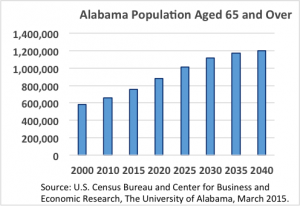TUSCALOOSA, Ala. — In light of May’s designation as Older Americans Month, the U.S. Census Bureau shared its projections that the number of people 65 and older in the country is expected to increase from 44.7 million in 2013 to 98.3 million in 2060. Staff at The University of Alabama Culverhouse College of Commerce’s Center for Business and Economic Research projected a rising trend in the older population in Alabama mirroring that of the U.S.
The number of Alabama residents 65 and older is expected to increase from 721,166 in 2013 to 1.2 million in 2040, the UA researchers said.

Using cohort-component methodology and taking into account economic trends, the UA Center’s researchers projected Alabama population by age groups. With aging baby boomers and declining birth rates and net migration, the share of older population is projected to increase from 13.8 percent in 2010 to 21.5 percent in 2040 for people 65 and over.
The share of Alabamians 85 and older is expected to increase from 1.6 to 3.0 percent during the same period.
The share of younger population is projected to decline in Alabama at the same time, following a nationwide trend.
The Census Bureau predicts that the population 65 and older would outnumber people younger than 18 in the U.S. in 2033. For Alabama, such a year may come sometime after 2040.
An aging population is expected to impact the state and local economies. It would require availability of accessible housing and nursing facilities as well as changes in health care and transportation services.
Some counties in Alabama will face more changes than others. The share of population 65 and older is expected to increase to 30 percent or higher in Cherokee, Conecuh and Coosa counties by 2040, according to researchers in the UA Center for Business and Economic Research. In comparison, Pike, Russell and Tuscaloosa counties are projected to have older population accounting for 17 percent or lower of their residents.
Summarized results of population projections are available at http://cber.cba.ua.edu/edata/est_prj.html. CBER projects population for Alabama counties by age, race and gender using cohort component method.
The Center for Business and Economic Research in the Culverhouse College of Commerce at The University of Alabama was created in 1930, and since that time it has engaged in research programs to promote economic development in the state and provide economic and demographic forecasting, data and analysis.
Contact
Edith Parten, UA media relations, eparten@Culverhouse.ua.edu, 205/348-8318
Source
Viktoria Riiman, research associate, 205/348-3757, vriiman@cba.ua.edu